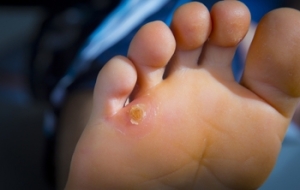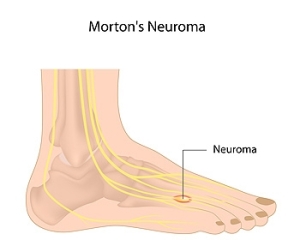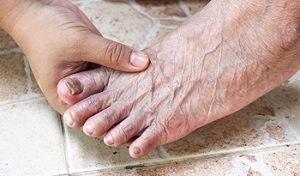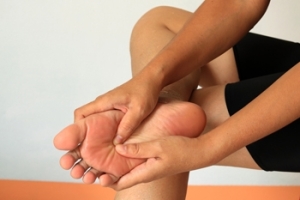Super User
Foot Conditions and Pregnancy
 When pregnancy occurs, the overall body prepares to accommodate the developing fetus. One of the most common conditions affecting the feet is referred to as flat feet. This may be a result of the additional weight that is placed on the body, and the arch in the foot may temporarily disappear. There may be pain associated with this condition, and research has shown it may be beneficial to wear shoes that may ease any discomfort. Additionally, many women who are pregnant may notice swelling in the feet, which can typically occur in the second or third trimester. This may be a result of increased blood pressure, and comfort may be gained from frequently sitting down, and elevating the feet. It may be helpful to drink plenty of fresh water daily, and this may aid in staying hydrated. If you are pregnant and are experiencing any type of foot pain, it is suggested that you speak to a podiatrist who can properly guide you on helpful preventative measures.
When pregnancy occurs, the overall body prepares to accommodate the developing fetus. One of the most common conditions affecting the feet is referred to as flat feet. This may be a result of the additional weight that is placed on the body, and the arch in the foot may temporarily disappear. There may be pain associated with this condition, and research has shown it may be beneficial to wear shoes that may ease any discomfort. Additionally, many women who are pregnant may notice swelling in the feet, which can typically occur in the second or third trimester. This may be a result of increased blood pressure, and comfort may be gained from frequently sitting down, and elevating the feet. It may be helpful to drink plenty of fresh water daily, and this may aid in staying hydrated. If you are pregnant and are experiencing any type of foot pain, it is suggested that you speak to a podiatrist who can properly guide you on helpful preventative measures.
Pregnant women with swollen feet can be treated with a variety of different methods that are readily available. For more information about other cures for swollen feet during pregnancy, consult with one of our podiatrists from Carolina Foot & Ankle. Our doctors will attend to all of your foot and ankle needs.
What Foot Problems Can Arise During Pregnancy?
One problem that can occur is overpronation, which occurs when the arch of the foot flattens and tends to roll inward. This can cause pain and discomfort in your heels while you’re walking or even just standing up, trying to support your baby.
Another problem is edema, or swelling in the extremities. This often affects the feet during pregnancy but tends to occur in the later stages.
How Can I Keep My Feet Healthy During Pregnancy?
- Wearing orthotics can provide extra support for the feet and help distribute weight evenly
- Minimize the amount of time spent walking barefoot
- Wear shoes with good arch support
- Wear shoes that allow for good circulation to the feet
- Elevate feet if you experience swelling
- Massage your feet
- Get regular, light exercise, such as walking, to promote blood circulation to the feet
If you have any questions please feel free to contact one of our offices located in Huntersville Office | 16419 Northcross Dr Suite A, Huntersville, NC 28078; Mooresvillle Office | 206 Joe Knox Avenue Suite D, Mooresville, NC 28117; and Mountain Island | 10310 Couloak Drive Suite 200, Charlotte, NC 28216 . We offer the newest diagnostic and treatment technologies for all your foot and ankle needs.
Pregnancy and Foot Health
Many pregnant women complain about foot pain while they are expecting. Foot pain can primarily be caused by weight gain and hormonal changes taking place in the body. By understanding how pregnancy impacts the health of a woman's feet, a pregnant woman can take action to keep her feet as healthy and comfortable as possible.
Because a woman's weight changes during pregnancy, more pressure is brought to bear on both the legs and the feet. This weight shift can cause two major foot problems: over-pronation, also known as flat feet, as well as edema, which is swelling of the feet. Over-pronation occurs when the arch of the foot flattens, causing the foot to roll inwards when the individual is walking, and can aggravate the plantar fascia tissues located along the bottom of the feet. If these tissues become inflamed, a pregnant woman can experience pain in the heel of the foot as well as severe foot pain while walking or standing. Swelling of the feet, or edema, often occurs in the later stages of pregnancy. It is caused by slow circulation and water retention, and may turn the feet a light purple color.
To keep feet in good health and prevent over-pronation, pregnant women should avoid walking barefoot and be sure they are wearing shoes that offer good arch support. A device known as an orthotic can be added to regular footwear in order to provide additional support for the feet during pregnancy. Any expectant mother whose feet hurt should first check to see if the shoes she is wearing are old, worn out and not offering the proper support necessary for distributing the weight of her body during pregnancy.
To treat edema of the feet, a good start is to wear quality footwear which offers support and good circulation. Keep feet elevated whenever possible by using a foot stool while seated. Stay well hydrated by drinking plenty of water to prevent water retention in the feet. Any swelling that occurs in only one foot should be examined as soon as possible by a doctor.
Good foot health during pregnancy can help expectant mothers avoid foot pain that leads to other health problems. Massaging the feet and doing regular gentle exercise like walking aids foot health by contributing to good circulation. Supportive shoes are also a good investment that will support foot health during pregnancy.
Protecting Your Feet from Plantar Warts at the Gym
 Plantar warts are small growths that mainly appear at the bottom of your foot and are a common viral skin infection. Unfortunately, they spread easily and being cautious in certain public spaces is key to protecting your feet. One public space to be especially vigilant in is the gym. It is important to always wear shoes at the gym, specifically near pools, in locker rooms and showers. Simply keeping a pair of shower shoes or flip flops in your gym bag helps to keep your feet safe from the multitude of bacteria that they would otherwise be exposed to. Additionally, any cuts or small wounds should always be covered. If you have a cut, it is also a good idea to stay away from saunas and hot tubs until it is healed. Covering your feet in order to prevent contact with an infected area is the best way to avoid these uncomfortable warts. If you think you may have contracted plantar warts, it is recommended that you speak to a podiatrist to receive proper treatment.
Plantar warts are small growths that mainly appear at the bottom of your foot and are a common viral skin infection. Unfortunately, they spread easily and being cautious in certain public spaces is key to protecting your feet. One public space to be especially vigilant in is the gym. It is important to always wear shoes at the gym, specifically near pools, in locker rooms and showers. Simply keeping a pair of shower shoes or flip flops in your gym bag helps to keep your feet safe from the multitude of bacteria that they would otherwise be exposed to. Additionally, any cuts or small wounds should always be covered. If you have a cut, it is also a good idea to stay away from saunas and hot tubs until it is healed. Covering your feet in order to prevent contact with an infected area is the best way to avoid these uncomfortable warts. If you think you may have contracted plantar warts, it is recommended that you speak to a podiatrist to receive proper treatment.
Plantar warts can be very uncomfortable. If you need your feet checked, contact one of our podiatrists from Carolina Foot & Ankle. Our doctors will assist you with all of your foot and ankle needs.
About Plantar Warts
Plantar warts are the result of HPV, or human papillomavirus, getting into open wounds on the feet. They are mostly found on the heels or balls of the feet.
While plantar warts are generally harmless, those experiencing excessive pain or those suffering from diabetes or a compromised immune system require immediate medical care. Plantar warts are easily diagnosed, usually through scraping off a bit of rough skin or by getting a biopsy.
Symptoms
- Lesions on the bottom of your feet, usually rough and grainy
- Hard or thick callused spots
- Wart seeds, which are small clotted blood vessels that look like little black spots
- Pain, discomfort, or tenderness of your feet when walking or standing
Treatment
- Freezing
- Electric tool removal
- Laser Treatment
- Topical Creams (prescription only)
- Over-the-counter medications
To help prevent developing plantar warts, avoid walking barefoot over abrasive surfaces that can cause cuts or wounds for HPV to get into. Avoiding direct contact with other warts, as well as not picking or rubbing existing warts, can help prevent the further spread of plantar warts. However, if you think you have developed plantar warts, speak to your podiatrist. He or she can diagnose the warts on your feet and recommend the appropriate treatment options.
If you have any questions please feel free to contact one of our offices located in Huntersville Office | 16419 Northcross Dr Suite A, Huntersville, NC 28078; Mooresvillle Office | 206 Joe Knox Avenue Suite D, Mooresville, NC 28117; and Mountain Island | 10310 Couloak Drive Suite 200, Charlotte, NC 28216 . We offer the newest diagnostic and treatment technologies for all your foot and ankle needs.
Plantar Warts
Plantar warts are growths that typically appear on the heels or other weight-bearing areas of the feet. These warts are caused by the human papillomavirus (HPV). The virus enters the body through breaks in the skin, such as cuts, that are on the bottom of the feet. Plantar warts are more likely to affect children and teenagers, people with weakened immune systems, people who have a history with plantar warts, and people who walk barefoot in environments exposed to a wart-causing virus.
If you suspect you have plantar warts, you may have the following symptoms: pain or tenderness while walking, a lesion that interrupts the ridges in the skin of your foot, small fleshy lesions on the bottom of the foot, or a callus where a wart has grown inward over a well-defined spot on the skin.
HPV causes plantar warts to form and is very common. There are more than 100 kinds of the virus in existence. However, only a few of them cause warts on the feet. The other types of HPV are likely to cause warts on other parts of the body.
If you have plantar warts, your podiatrist may try different treatment methods depending on your specific case. Some treatments for plantar warts are peeling medicines (salicylic acid), freezing medicines (cryotherapy), or surgical procedures. Laser treatments and vaccines are also used to treat plantar warts.
Possible Treatment of Morton’s Neuroma
 The painful and uncomfortable foot condition that is known as Morton’s neuroma will typically affect the area between the third and fourth toes on the sole of the foot. The pain may originate from a swollen nerve in the ball of the foot and may be exaggerated by wearing specific types of shoes that may include high heels. There may be available treatment options that can include steroid injections, ingesting painkillers, or by simply changing the footwear. If the symptoms appear to be severe, surgery may be considered if other treatments have been unsuccessful. This type of surgery generally includes removing the pressure and affected nerve, which can be accomplished by a few different methods. It is strongly advised to consult with a podiatrist, so a proper diagnosis and correct treatment can be determined.
The painful and uncomfortable foot condition that is known as Morton’s neuroma will typically affect the area between the third and fourth toes on the sole of the foot. The pain may originate from a swollen nerve in the ball of the foot and may be exaggerated by wearing specific types of shoes that may include high heels. There may be available treatment options that can include steroid injections, ingesting painkillers, or by simply changing the footwear. If the symptoms appear to be severe, surgery may be considered if other treatments have been unsuccessful. This type of surgery generally includes removing the pressure and affected nerve, which can be accomplished by a few different methods. It is strongly advised to consult with a podiatrist, so a proper diagnosis and correct treatment can be determined.
Morton’s neuroma is a very uncomfortable condition to live with. If you think you have Morton’s neuroma, contact one of our podiatrists of Carolina Foot & Ankle. Our doctors will attend to all of your foot care needs and answer any of your related questions.
Morton’s Neuroma
Morton's neuroma is a painful foot condition that commonly affects the areas between the second and third or third and fourth toe, although other areas of the foot are also susceptible. Morton’s neuroma is caused by an inflamed nerve in the foot that is being squeezed and aggravated by surrounding bones.
What Increases the Chances of Having Morton’s Neuroma?
- Ill-fitting high heels or shoes that add pressure to the toe or foot
- Jogging, running or any sport that involves constant impact to the foot
- Flat feet, bunions, and any other foot deformities
Morton’s neuroma is a very treatable condition. Orthotics and shoe inserts can often be used to alleviate the pain on the forefront of the feet. In more severe cases, corticosteroids can also be prescribed. In order to figure out the best treatment for your neuroma, it’s recommended to seek the care of a podiatrist who can diagnose your condition and provide different treatment options.
If you have any questions, please feel free to contact one of our offices located in Huntersville Office | 16419 Northcross Dr Suite A, Huntersville, NC 28078; Mooresvillle Office | 206 Joe Knox Avenue Suite D, Mooresville, NC 28117; and Mountain Island | 10310 Couloak Drive Suite 200, Charlotte, NC 28216 . We offer the newest diagnostic and treatment technologies for all your foot care needs.
What is Morton's Neuroma?
Morton’s neuroma, (also referred to as Morton’s metatarsalgia, Morton’s neuralgia, plantar neuroma or intermetatarsal neuroma) is a condition that is caused when the tissue around one of the nerves between your toes begins to thicken. This thickening can result in pain in the ball of the foot. Fortunately, the condition itself is not cancerous.
Morton’s neuroma affects women more often than men with a ratio of 4:1. It tends to target women between the age of 50 and 60, but it can occur in people of all ages. There are some risk factors that may put you at a slightly higher risk of developing the condition. People who often wear narrow or high-heeled shoes are often found to be linked to Morton’s neuroma. Additionally, activities such as running or jogging can put an enormous amount of pressure on the ligament and cause the nerve to thicken.
There usually aren’t any outward symptoms of this condition. A person who has Morton’s neuroma may feel as if they are standing on a pebble in their shoe. They may also feel a tingling or numbness in the toes as well as a burning pain in the ball of their foot that may radiate to their toes.
In order to properly diagnose you, the doctor will press on your foot to feel for a mass or tender spot. He may also do a series of tests such as x-rays, an ultrasound, or an MRI. X-rays are usually done to rule out any other causes for your foot pain such as a stress fracture. Ultrasounds are used to reveal soft tissue abnormalities that may exist, such as neuromas. Your podiatrist may want to use an MRI in order to visualize your soft tissues.
There are three main options for treatment of Morton’s neuroma: Injections, decompression surgery, and removal of the nerve. Injections of steroids into the painful area have been proven to help those with Morton’s neuroma. Decompression surgery has been shown to relieve pressure on the affected nerve by cutting nearby structures such as the ligaments in the foot. Another treatment option would be to surgically remove the growth to provide pain relief.
If you suspect that you have Morton’s neuroma you should make an appointment with your podiatrist right away. You shouldn’t ignore any foot pain that lasts longer than a few days, especially if the pain does not improve.
How To Prevent Certain Foot Conditions in the Elderly
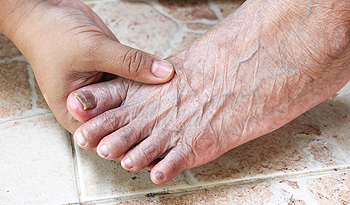 There are many elderly people who may experience foot conditions as they age. Recent research has shown there may be ways to prevent certain foot issues from occurring. The most common preventative measure may be to wear shoes that fit correctly, which may maintain maximum comfortability. It’s beneficial to measure the feet frequently, because they may widen with age. Additionally, many elderly people recognize the importance of avoiding poor circulation in the feet. This may be accomplished by stretching the feet frequently and walking regularly. Athletes foot may be a common foot ailment among seniors, and this may be avoided by wearing appropriate shoes in public showers and surrounding areas. If you are responsible for properly caring for an elder’s feet, please consult with a podiatrist for additional information.
There are many elderly people who may experience foot conditions as they age. Recent research has shown there may be ways to prevent certain foot issues from occurring. The most common preventative measure may be to wear shoes that fit correctly, which may maintain maximum comfortability. It’s beneficial to measure the feet frequently, because they may widen with age. Additionally, many elderly people recognize the importance of avoiding poor circulation in the feet. This may be accomplished by stretching the feet frequently and walking regularly. Athletes foot may be a common foot ailment among seniors, and this may be avoided by wearing appropriate shoes in public showers and surrounding areas. If you are responsible for properly caring for an elder’s feet, please consult with a podiatrist for additional information.
Proper foot care is something many older adults forget to consider. If you have any concerns about your feet and ankles, contact one of our podiatrists from Carolina Foot & Ankle. Our doctors can provide the care you need to keep you pain-free and on your feet.
The Elderly and Their Feet
As we age we start to notice many changes in our body, but the elder population may not notice them right away. Medical conditions may prevent the elderly to take notice of their foot health right away. Poor vision is a lead contributor to not taking action for the elderly.
Common Conditions
- Neuropathy – can reduce feeling in the feet and can hide many life-threatening medical conditions.
- Reduced flexibility – prevents the ability of proper toenail trimming, and foot cleaning. If left untreated, it may lead to further medical issues.
- Foot sores – amongst the older population can be serious before they are discovered. Some of the problematic conditions they may face are:
- Gouging toenails affecting nearby toe
- Shoes that don’t fit properly
- Pressure sores
- Loss of circulation in legs & feet
- Edema & swelling of feet and ankles
Susceptible Infections
Diabetes and poor circulation can cause general loss of sensitivity over the years, turning a simple cut into a serious issue.
If you have any questions please feel free to contact one of our offices located in Huntersville Office | 16419 Northcross Dr Suite A, Huntersville, NC 28078; Mooresvillle Office | 206 Joe Knox Avenue Suite D, Mooresville, NC 28117; and Mountain Island | 10310 Couloak Drive Suite 200, Charlotte, NC 28216 . We offer the newest diagnostic and treatment technologies for all your foot and ankle needs.
Elderly Foot Care
As you grow older, you will start to notice more problems with your feet due to wear and tear. This may also happen because the skin will start to become thin and lose elasticity. Some signs of aging feet are regular aches and pains, bunion development, and clawed toes.
Fortunately, there are ways you can improve comfort, relieve pain, and maintain mobility in your feet. One of the best ways to deal with aging feet is to exercise. If you keep active, your muscles will become toned which will then strengthen the arches in the foot and stimulate blood circulation.
It is important that you practice proper foot care to protect your aging feet. You should wash your feet in warm water on an everyday basis. Afterward, the feet need to be dried well and it is important to dry between the toes. Your toenails should be trimmed and kept under control; nails that are poorly cut may become ingrown. At the end of each day, performing an inspection of your feet will allow you to detect any ailments in their early stages.
As you grow older, it becomes more important that you wear comfortable shoes. Your shoes should be secure, and they should provide decent arch support. If you are looking to buy a new pair of shoes, it is best to look for a pair that are made from a breathable material. It is also helpful to have shoes that have a bit of extra room at the top of the shoe, especially if you suffer from swollen feet.
The most common foot problems that elderly people will encounter are bunions, calluses, corns, hammertoes, heel pain, and foot problems related to diabetes. Some other issues include arch pain, tarsal tunnel syndrome, Achilles tendonitis, and Morton’s neuroma
An annual foot examination is a great way for you to ensure that you do not have any serious health problems with your feet. You should talk to a podiatrist about the available treatment options for whichever foot issue you are dealing with.
Where Are the Sesamoid Bones Located?
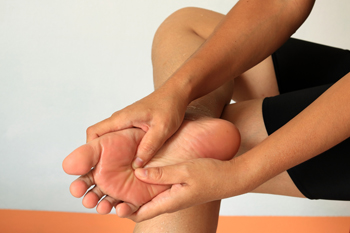 The location of the sesamoid bones is found under the base of the big toe. They sit within tendons and ligaments under the joint of the big toe, and if this area should become inflamed, a condition that is referred to as sesamoiditis may develop. There may be several reasons for this uncomfortable ailment to occur, including enduring an acute injury, or the pain may develop gradually from stress fractures. Additionally, there may be medical conditions, which may contribute to the onset of this condition, which may include autoimmune disorders or infections that may be present. Patients who experience sesamoiditis may notice pain while putting weight on the affected toe, or severe discomfort may be felt while pulling the toe upwards. A proper diagnosis may consist of having an X-ray or MRI performed. If you feel you have any of these symptoms, consult with a podiatrist so proper treatment can begin.
The location of the sesamoid bones is found under the base of the big toe. They sit within tendons and ligaments under the joint of the big toe, and if this area should become inflamed, a condition that is referred to as sesamoiditis may develop. There may be several reasons for this uncomfortable ailment to occur, including enduring an acute injury, or the pain may develop gradually from stress fractures. Additionally, there may be medical conditions, which may contribute to the onset of this condition, which may include autoimmune disorders or infections that may be present. Patients who experience sesamoiditis may notice pain while putting weight on the affected toe, or severe discomfort may be felt while pulling the toe upwards. A proper diagnosis may consist of having an X-ray or MRI performed. If you feel you have any of these symptoms, consult with a podiatrist so proper treatment can begin.
Sesamoiditis is an unpleasant foot condition characterized by pain in the balls of the feet. If you think you’re struggling with sesamoiditis, contact one of our podiatrists of Carolina Foot & Ankle. Our doctors will treat your condition thoroughly and effectively.
Sesamoiditis
Sesamoiditis is a condition of the foot that affects the ball of the foot. It is more common in younger people than it is in older people. It can also occur with people who have begun a new exercise program, since their bodies are adjusting to the new physical regimen. Pain may also be caused by the inflammation of tendons surrounding the bones. It is important to seek treatment in its early stages because if you ignore the pain, this condition can lead to more serious problems such as severe irritation and bone fractures.
Causes of Sesamoiditis
- Sudden increase in activity
- Increase in physically strenuous movement without a proper warm up or build up
- Foot structure: those who have smaller, bonier feet or those with a high arch may be more susceptible
Treatment for sesamoiditis is non-invasive and simple. Doctors may recommend a strict rest period where the patient forgoes most physical activity. This will help give the patient time to heal their feet through limited activity. For serious cases, it is best to speak with your doctor to determine a treatment option that will help your specific needs.
If you have any questions please feel free to contact one of our offices located in Huntersville Office | 16419 Northcross Dr Suite A, Huntersville, NC 28078; Mooresvillle Office | 206 Joe Knox Avenue Suite D, Mooresville, NC 28117; and Mountain Island | 10310 Couloak Drive Suite 200, Charlotte, NC 28216 . We offer the newest diagnostic and treatment technologies for all your foot and ankle needs.
Sesamoiditis
Sesamoiditis is a condition in which the sesamoid bones in the forefoot become inflamed from physical activity. Sesamoid bones are bones that are not connected to other bones but are located in tendons or muscle. Two of these sesamoid bones are very small and located on the underside of the foot near the big toe. Athletes such as runners, baseball and football players, and dancers are likely to experience sesamoiditis. Those with high arched feet, flat feet, or runners who run on the ball of their foot are also prone to suffer from sesamoiditis.
Symptoms include pain or throbbing on the ball of the foot near the big toe. The pain generally starts with a mild throbbing but gradually builds up to shooting pain. Bruising, swelling, and redness are possible, but in most cases, these symptoms are not present. However, moving the big toe can result in pain and difficulty.
To conduct a diagnosis, the podiatrist will examine the ball of the foot and big toe. They will look for any outliers and check the movement of the toe. X-rays will be taken to rule out any other conditions and ensure that it is sesamoiditis.
Treatment for sesamoiditis is generally mild and includes rest, anti-inflammatory and pain medication, and ice treatments to deal with the swelling and pain. Orthotics may be needed with people who have flat or high arched feet to relieve pressure off the bones. In some cases the toe will be taped and immobilized to allow healing. The podiatrist may also decide to use a steroid injection to help with swelling as well. If you have sesamoiditis, you shouldn’t engage in any intensive activity, as it may inflame the area and worsen your pain. If the sesamoid bone has fractured, surgery may be required to remove the sesamoid bone.
If you are suffering from sesamoiditis or are experiencing symptoms similar to sesamoiditis, you should stop all physical activity that puts strain on the area. Furthermore you should see a podiatrist for a diagnosis to see if you have sesamoiditis.

